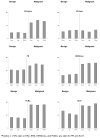Soy consumption and histopathologic markers in breast tissue using tissue microarrays
- PMID: 19838945
- PMCID: PMC2903450
- DOI: 10.1080/01635580902913047
Soy consumption and histopathologic markers in breast tissue using tissue microarrays
Abstract
This study examined the relation of soy intake with hormonal and proliferation markers in benign and malignant breast tissue using tissue microarrays (TMAs). TMAs with up to 4 malignant and 4 benign tissue samples for 268 breast cancer cases were constructed. Soy intake in early life and in adulthood was assessed by questionnaire. The TMAs were stained for estrogen receptor (ER) alpha, ERbeta, progesterone receptor (PR), human epidermal growth factor receptor 2 (HER2/neu), proliferating cell nuclear antigen (PCNA), and Ki-67 using standard immunohistochemical methods. Logistic regression was applied for statistical analysis. A higher percentage of women showed positive marker expression in malignant than in benign tissue. With one exception, HER2/neu, no significant associations between soy intake and pathologic markers were observed. Early life soy intake was associated with lower HER2/neu and PCNA staining of malignant tissue. In benign tissue, early life soy intake showed higher ER and PR expression, but no difference in proliferation markers. The results of this investigation provide some assurance that soy intake does not adversely affect markers of proliferation. TMAs were shown to be a useful tool for epidemiologic research.
Figures
References
-
- Trock BJ, Hilakivi-Clarke L, Clarke R. Meta-analysis of soy intake and breast cancer risk. J Natl Cancer Inst. 2006;98:459–471. - PubMed
-
- Henderson BE, Pike MC, Bernstein L, Ross RK. In: Breast cancer. Schottenfeld D, editor. Oxford University Press; New York: 1996. pp. 1022–1039.
-
- Russo J, Hu YF, Yang X, Russo IH. Developmental, cellular, and molecular basis of human breast cancer. J Natl Cancer Inst Monogr. 2000:17–37. - PubMed
Publication types
MeSH terms
Substances
Grants and funding
LinkOut - more resources
Full Text Sources
Medical
Research Materials
Miscellaneous


